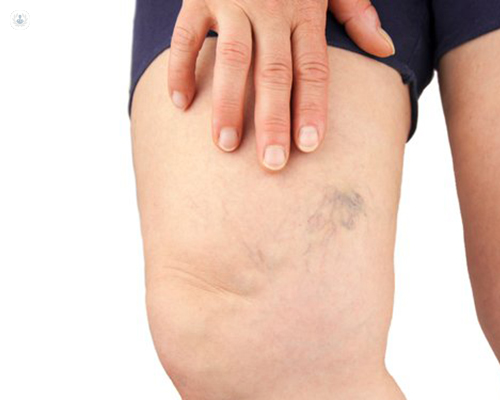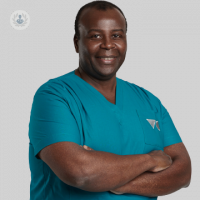What is the difference between spider veins and varicose veins?
Written by:If you experience discoloured or enlarged veins, you’re not alone. But do you have anything to worry about? Mr Ed Sideso, a revered consultant vascular and endovascular surgeon, gives us his insights into what spider veins are and how they are different to varicose veins.

Spider veins – what are they?
Spider veins, or thread veins, are blood vessels that can be seen through the skin, which the patient may consider to be unsightly. They can be of different shape, size, and colour, but their appearance may be a source of embarrassment, causing the patient to hide the veins and avoid baring skin.
Spider veins could be incredibly fine, and red in colour, or they could branch over a larger area, almost looking like a bruise due to their purple shade. Some can be raised, some may be blue, and seemingly wriggle across the skin, but usually patients will have a mixture of the vein types.
Causes of spider veins
Most people experience thread veins in their lifetime, but it is true that certain people experience spider veins more than others.
For many, it is hereditary, but other factors can influence spider veins, such as pregnancy, prolonged standing, hormonal changes, or injuries. Most thread veins are found on the legs, and are usually more common in women than in men. As the patient ages, spider veins may get worse. They can come hand in hand with varicose veins, but it is important to note the difference.
Spider veins and varicose veins
Varicose veins and spider veins are not the same at all – spider veins are usually painless and while patients may experience aches or feel an itching sensation, they will not turn into varicose veins. Spider veins do not cause major health issues but could be the reason for some discomfort. Along with this, and the fact that some veins can be facial, many patients prefer to receive treatment for their thread veins.
Treatment options
If you are worried about spider veins, remember to always consult a specialist and book an appointment to see your doctor. They can assess the need for treatment and discuss options with you.
Sclerotherapy
This is the most common choice of treatment for thread veins on the legs. Sclerotherapy involves introducing a small disposable needle into a vein, so a tiny amount of sclerosant solution can be injected. The solution breaks down the lining in the vein so blood cannot flow through it any more. The remaining tissue disappears over time thanks to the body’s natural mechanisms. The treatment takes only around 30 minutes and the patient can return to work immediately.
Laser treatment
Laser therapy is extremely successful with facial thread veins. The procedure uses a beam of light and targets the vein, heating it up to destroy it. Treatment time is similar to sclerotherapy and the patient can return to their normal daily activities afterwards.
Electrolysis
The least popular of the treatments, electrolysis involves inserting a probe along the vein at different intervals, and applying an electric current to eliminate them.
Mr Ed Sideso is a distinguished vascular surgeon with over 20 years of experience. You can schedule an appointment with Mr Sideso by visiting his Top Doctors profile.


